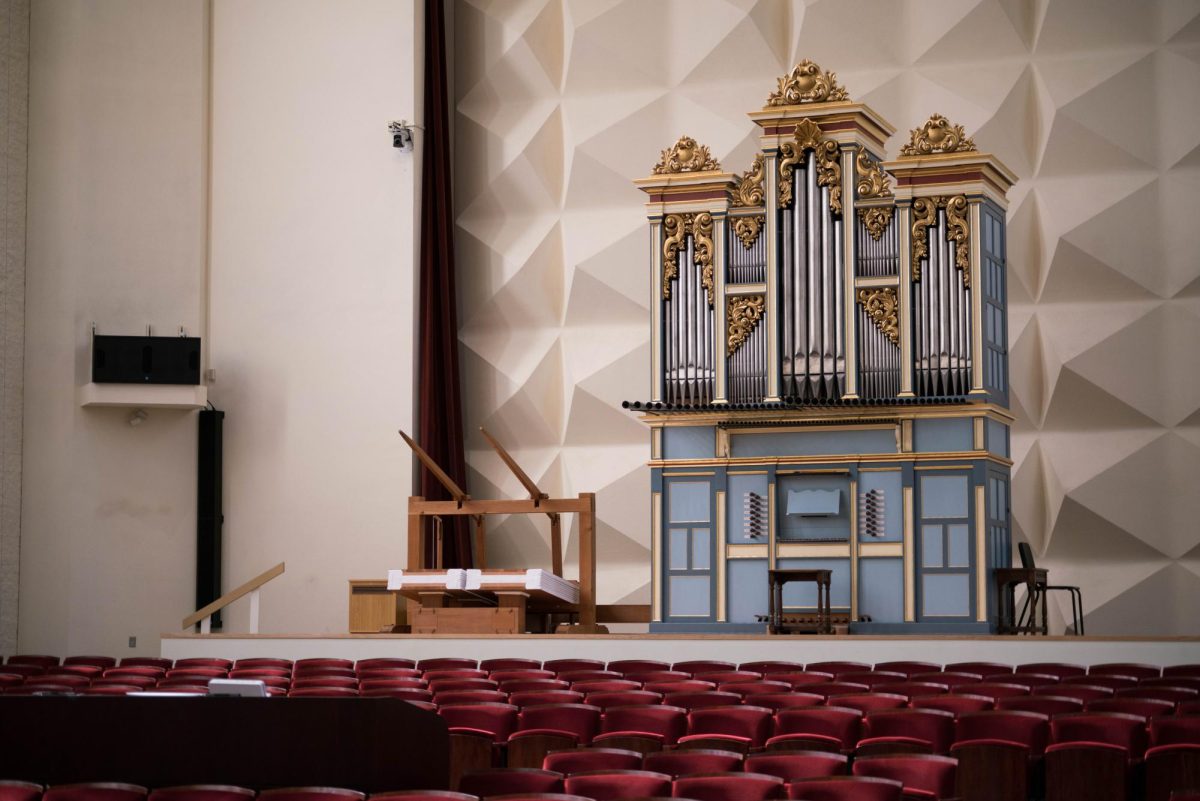Oberlin boasts a world-renowned collection of pipe organs. Students have access to 32 instruments in the Conservatory and nearby churches, ranging in grandeur and specialization. These instruments display a 500-year history of organ construction and reflect diverse designs across European schools and eras. Each organ offers a glance back at a different moment in history, depending on the style they were modeled after. From grandiose concert halls to sunny practice rooms, no two instruments are the same, and they each have unique purposes.
“I look at the instruments here as windows into specific times,” Oberlin Curator of Organs David Kazimir, OC ’99, said. “It’s a laboratory where we can take students to discover music.”
Since the 19th century, Oberlin has been considered one of the leading institutions for organ instruction in the United States. Organs remain an integral part of the musical tapestry, due in part to the College’s religious foundation as a school to train gospel ministers and other Christian leaders, since sacred music often requires a pipe organ. Oberlin purchased its first organ for the College chapel in 1883 with funds from Conservatory President Fenelon B. Rice. In 1903, a fire in the chapel destroyed this instrument, sparking a flurry of organ acquisitions. By 1916, the organ department included four concert organs and 22 practice instruments.
On our campus today, a pipe organ is always a short walk away. Warner Concert Hall is home to a huge Flentrop organ built in the classical North European style, as well as a smaller Spanish-style organ. Inside Fairchild Chapel sits a mechanical-action organ built in 1981 by John Brombaugh, which was lauded in the magazine Organ as the most outstanding instrument yet built in the 20th century. And of course, the organ in Finney Chapel makes up the core of Oberlin’s collection.
The most recent addition to Oberlin’s showcase organs, the Opus 116, cost $1,185,000. The company C.B. Fisk, Inc., based out of Gloucester, Massachusetts, derived their design from the French master organ builder Aristide Cavaillé-Coll, building Opus 116 to complement the music of French romantic composers. The instrument possesses 4,014 pipes and 57 individual voices, some higher than a dog whistle and others too low for a human ear to detect. What is unique about Opus 116 is its dual modes. The modern American mode controls the stop action with pistons and uses digital technology to store and recall multiple instrument configurations. The more traditional Francais mode disables the pistons and utilizes a system of pedals to release air that manipulate the flues, reeds, and couplers.
“The Fisk company itself reflects a lot of what Oberlin was doing in terms of discovering the history of the craft,” Kazimir said. “Charles Fisk, the founder, loved the French school of Baroque and romantic instruments and drove his company in a way that took modern inventions and conveniences, but captured the essence of history and made it seem alive.”
In the 1960s, Oberlin made a controversial decision for its organ collection. Rather than acquire more technologically advanced instruments, they chose to focus on historical accuracy. The organ faculty of Oberlin recognized that the complexity of electronic components were destroying the original intentions. Organs represent a marvel of human invention, and technology merely muddies the already complicated and impressive mechanics.
“We looked at the organ builders that were engaged, looked at the times in which specific instruments were built, the musicians that influenced them, and took a little Jurassic Park DNA to design organs around,” Kazimir said.
At the time, the choice to abandon technology in favor of historical accuracy was ridiculed. The philosophy of historically-informed performance was only just beginning. Now, most major conservatories strive to replicate Oberlin’s organ collection. The assortment allows space for a wide range of music. During recitals, organ students make use of multiple instruments in order to compliment the tonal quality of their piece.
“We’re used to a walking intermission,” Kazimir explained. “A senior recital might start off in Fairchild Chapel back in the earliest days of organ music with things from the 14th century. During intermission, we walk over to Paris in Finney Chapel.”
The diversity of pipe organs at Oberlin creates endless educational opportunities. Students can apply historical methods of performance directly to their personal studies. Faculty and masterclasses from world-renowned organists encourage a broad repertoire. It is clear from Oberlin’s traditional Organ Pump performances in Finney Chapel, in which audience members are invited to lie down onstage and experience the deep vibrations of Opus 116, that the organ is an important aspect of the school’s identity. It mixes tradition and historical accuracy with modern innovation and experimentation, a core tenet of the Conservatory.
“What was music like in the Renaissance? Or in Paris in the 19th century? Or Spain in the 17th century?” Kazimir asked. “The principal concert instruments at Oberlin are like an encyclopedia of time and space. And there’s really nowhere else in the world where you can walk around and hear these different sounds.”





